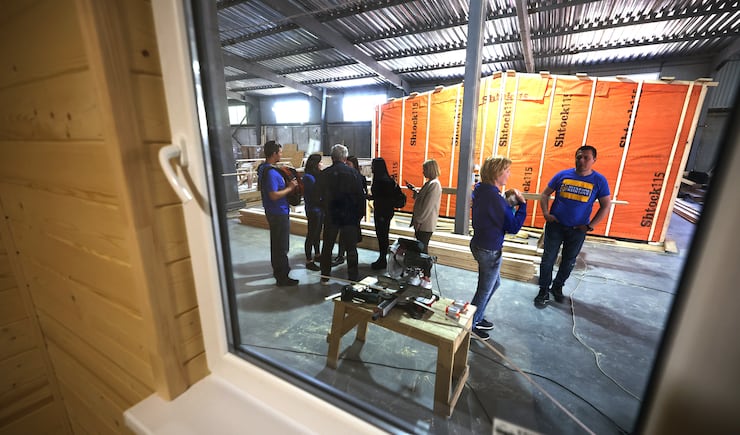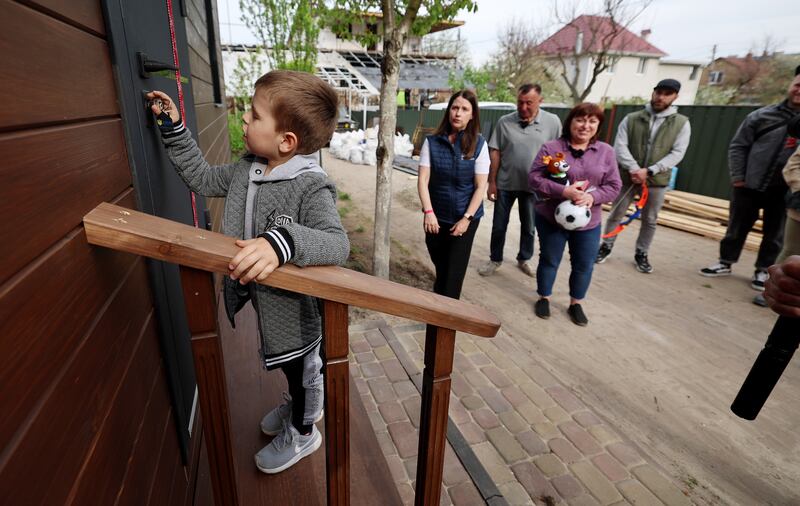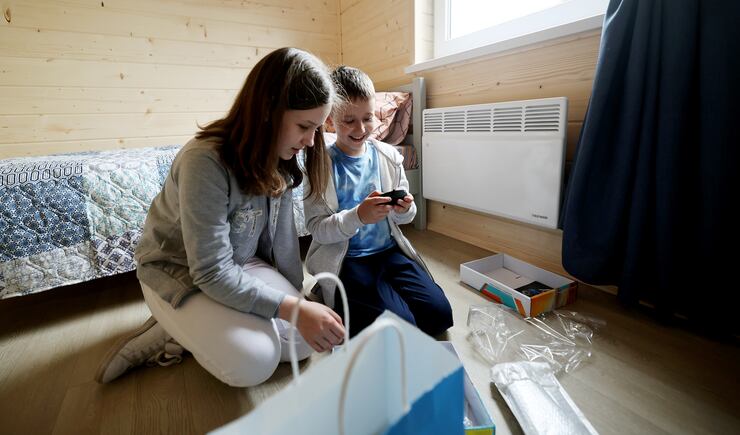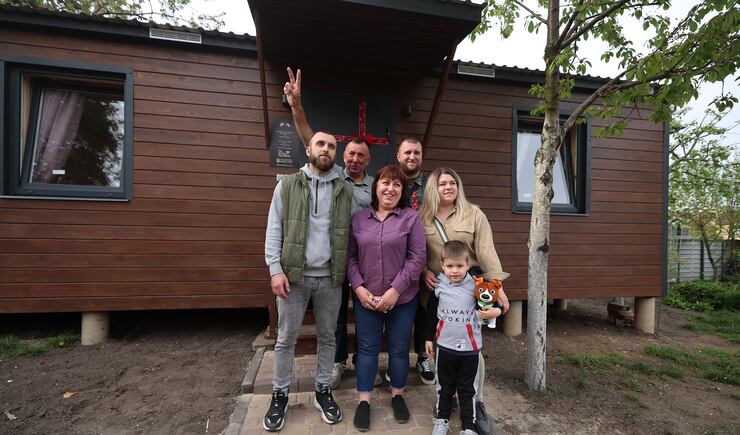Editor’s note: Deseret News Executive Editor Doug Wilks, reporter Katie McKellar and photojournalist Scott Winterton traveled with Utah’s trade and humanitarian delegation to Ukraine from April 29 to May 7.
Seven-year-old Yaroslav stood with his hands dangling at his sides staring at what remained of his bombed out home on a once peaceful street outside Kyiv.
His mother, Svitlanka Onischuk, held him by his shoulders. To her left was her 86-year-old grandmother, Dina. To her right, her daughter and Yaroslav’s big sister, Polinka, 10.
Svitlanka’s mother, Natalia, held an embroidered blue and yellow towel called a rushnyk and a loaf of bread sprinkled with salt. The traditional Ukrainian gifts were all the family had to offer in gratitude.
A gentle smile crossed the women’s faces as they welcomed a crowd of strangers that had traveled across the world to their suburban neighborhood in Irpin, just west of Ukraine’s capital city of Kyiv. It was one of the first cities Ukrainian forces reclaimed after Russia’s full-scale invasion on Feb. 24, 2022. Today, Svitlanka’s husband is fighting on the front lines, which currently extend around the country’s far east and south.
Yaroslav didn’t smile. It was probably too much for the second grader, who just over a year ago had lost his home under a fury of bombs, missiles, shrapnel and fire.
Surrounding the lot — now largely consumed by a blank slab of concrete that will perhaps someday serve as a new foundation if they’re ever able to rebuild — most of their neighbors’ homes stood intact.

Several in our group of Americans and Ukrainians carried cameras and held up our phones to capture the next chapter in the family’s war-ravaged life. As we gathered in the backyard to greet them, we stepped carefully around the white-flowered branches of a blossoming apple tree — one of many bordering their lot. There was also a garden, a little overgrown and in need of love, but thriving with greenery and pops of red flowers, soaking up Ukraine’s fresh springtime air.
Fortunately, the Onischuks evacuated in the early days of the invasion, escaping an explosion that later damaged the roof and exterior wall of their home. They’d hoped that would be the worst of it. “Lighting never strikes twice,” as Natalia put it. But at the end of March last year, before Ukrainians succeeded in pushing Russian soldiers back out of Irpin, they received devastating pictures of their house.
What was left of the brick walls were charred black. The rest was reduced to rubble. Everything they had owned had burned down. Three pet parrots they left behind burned alive.
When Irpin was liberated, the family came back. But, Natalia said, “we returned to nothing.”
The Onischuks’ home became a statistic. By the end of 2022, 10 months into the war, 149,300 residential buildings were damaged or destroyed in Ukraine, including 131,400 private houses, 17,500 apartment buildings and 280 dormitories. The destruction totals more than $54 billion in damage to the country’s housing stock, according to estimates from the Kyiv School of Economics. It affected more than 2.4 million Ukrainians.
Since then, the Onischuks’ home has been razed and the lot cleaned up. Only a small pile of rubble remains.
But today, next to the empty foundation, there was a new, four-bedroom modular home waiting for them. A red and white ribbon was tied around the front door. It is a fresh start for the Onischuk family.

The new home, hand built in a warehouse by Ukrainians hired by To Ukraine With Love, had been delivered to their lot. Svitlana Miller, who grew up in Kyiv but moved to the U.S. for college, founded the nonprofit. In Utah, she attended Brigham Young University, met her husband, Darin, and settled in Idaho. When Russia’s full-scale invasion broke out, Miller, desperate to help her people, launched her nonprofit, which fielded more than $2 million in donations in 2022.
To Ukraine With Love has since become a large-scale operation. On the front lines in the east, the nonprofit provides food, shelter and underground transportation to help Ukrainians out of Russian-occupied territories. In the west, it builds homes for families whose houses were destroyed.
As her team prepared to give the home’s keys to the Onischuks, Miller held a tablet so a remote representative of the home’s donors, the Utah-based nonprofit, the Stirling Foundation, could see and speak to the family. Several members of a delegation from Utah, visiting Ukraine on a whirlwind trade and humanitarian mission, also joined to witness the family’s coming home.
In its efforts to rebuild Ukraine “one village at a time,” To Ukraine With Love vets hundreds of families through local Ukrainian city administrations to decide who would receive homes, from those living in tents or tool sheds or even chicken coops to those renting places they can barely afford.
The Onischuks became one of those families.

“We’re grateful that there are people who worry about us and help us,” Natalia said through tears in Ukrainian, translated by Miller. “Thank you for not leaving us alone in our grief.”
It didn’t take long for emotions to overpower members of our group. Several of us began crying, wiping our eyes and noses.
Through my own watery eyes, I couldn’t help but to watch Yaroslav. His eyes turned red and brimmed with tears. As his grandmother continued to express deep thanks, it became too much for him. His mother later told me he cried and cried when he first found out their family would be getting a home.
He couldn’t “believe this kindness is happening to us. We’ve been without a home for so long I never thought it would happen,” Svitlanka said.
Today those emotions bubbled back up for Yaroslav. His face crumpled. His mother stooped down, holding his head into her neck. He broke out in uncontrollable sobs. His sister tried to console him, wiping his face and pulling his head into her chest.
“Finding out that we have a home now,” Natalia said, “came at the biggest moment of despair.”
As war continues to rage, they hope to move on with their lives.

“We wish for peace,” Natalia said. “We pray for peace.”
Though it was smaller than their old family home, the Onischuks’ new modular home was brightly lit and furnished with beds, a couch, a full kitchen and running water. It smelled of fresh pine, its wood paneling walls smooth to the touch.
The family’s faces glowed as they explored the home for the first time. The children darted to and from the bedrooms, trying to decide which one to claim for their own.
Inside one of the bedrooms, a surprise was waiting for Polinka and Yaroslav: A cage with two chirping, blue parakeets — a gift to replace the family’s pet birds that died when their home caught fire.
It was a personal touch Miller and her team made sure to pull off. Each family holds a special place in Miller’s heart. She remembers their stories and recites them gracefully to anyone who will listen.
Little did she know, in a few days Miller would be telling the story of To Ukraine With Love to President Volodymyr Zelenskyy face to face.
How did she get here?

How 4 Idaho boys started a movement
Last year, To Ukraine With Love’s early efforts were mostly focused on delivering supplies — first-aid kits, sleeping bags, drones, whatever was needed. Donations poured in as Russia’s invasion of Ukraine shocked the world.
But back home in Idaho Falls, Miller’s 13-year-old son, Chase, wanted to do more.
Miller and her husband had just returned from delivering aid to Ukraine and bringing her grandmother back with them. They showed Chase photos of destruction and videos of people clearing rubble in Bucha and Irpin, cities on the western outskirts of Kyiv.
The house of Miller’s own grandfather, who had died right before the invasion, “thank goodness,” Miller said, was damaged — shattered windows, leaking roof, wall riddled with bullet holes. They managed to recover only old wedding photos and family files.
Miller said her son, who remembered visiting his great-grandfather’s house, was moved. He wanted to go to Ukraine to see for himself. Miller told him he could only go if he brought aid. But Chase was thinking bigger.
“He said, ‘You know, I want to fundraise for a house,’” Miller told me on a Zoom call before the trip. At the time, she said To Ukraine With Love was exploring how modular homes, built in a warehouse at the cost of $18,000 to $35,000 each, could be delivered to the lots where destroyed homes once stood and tie into existing utility lines. They would come turn-key ready, appliances and all.

“I really want to buy one of those houses,” Miller recalled her son telling her. “And I said, ‘Well, that’s expensive.’” She noted he could feed 1,000 people a day for a month for $11,000. “I said, ‘Are you sure you want to do a house?’”
Chase insisted. So Miller and her husband told him if he raised $5,000, maybe they could sell their van and pay the remainder to give a home to one family. Chase agreed. From there, he and three friends started knocking on doors.
Five weeks later, the four boys had collected $60,000 in Idaho Falls. It was an amount “we never expected,” Miller said. It funded three homes for Ukrainian families last year.
“But the true miracle really happened when we came back from Ukraine. Because all of a sudden these boys had a voice,” Miller said.
As the boys showed their own video clips of the emotional home donations, the movement grew, uniting neighborhoods and churches. Professional documentary filmmakers offered to make high-quality videos of the home donations, Miller said, and To Ukraine With Love posted the videos on its YouTube channel.
It was a wild success for months — but it appeared it wouldn’t last. In January, after they had raised $700,000 for 30 homes, “I really just kind of ran out of steam,” Miller said. To Ukraine With Love’s other aid efforts called, and while the homes were hugely rewarding, they were also expensive and helped a smaller group of people when compared to meal centers or medical aid.
Even though the housing effort “felt so right,” Miller said she felt “really defeated” come February when she had to tell 56 Ukrainian warehouse workers who had been building the homes that the nonprofit was running out of money.
“So we traveled to Ukraine, and my husband and I sat down with this beautiful group, these wonderful people who had moved from western Ukraine, who moved to Kyiv region to have work, and we had to tell them, ‘We’re so sorry. We just have no more funds for houses.’”
It was a dark moment for Miller. She had fasted, prayed, hoped something would save the effort. But the answer didn’t come.
“It was a really sad day,” she said.








The phone call
After Miller told the warehouse staff that they would be out of work, she was on her way to visit a hot meal center when she got a call.
It was Dell Loy Hansen, a Utah businessman and founder of the real estate investment firm Wasatch Group. To Ukraine With Love’s YouTube channel had caught his attention. He wanted to talk.
Miller recalled Hansen telling her how impressed he was with the 30 homes she had built in so little time, and he wondered where the effort stood now. Miller said she had just told the builders they had to look for new work.
“Can you pull over right now? Is there a place you can pull over? I want you to call these builders, every single one of them and tell them they have their jobs back,” Hansen told her on the phone.
Taken aback, Miller balked. “Who was this guy?” she remembered thinking. How did she know she could trust him? The last thing she wanted was to give the warehouse workers false hope.
Hansen pledged to sponsor 20 houses a month, and eventually more.
Miller didn’t know what to think. But the next morning, she woke up to an astonishing text message from her bank: A $500,000 deposit in To Ukraine With Love’s account.
She told the builders they had their jobs back. She went to eligible Ukrainians living on destroyed streets, telling them, “You’re getting a house. You’re getting a house. You’re going to get a house in the next few weeks. All these people were crying.”
Hansen joined Zoom calls each morning to see displaced Ukrainians getting their new homes. He cried with them and told them how much he loves them. “And then he loved the 20 families we helped the first month so much, he said, ‘Let’s do 50. We can scale this to 50 houses a month,’” Miller said.
To Ukraine With Love expanded from 56 home builders to over 100 in May and opened a new warehouse. Hansen and his partners committed some $1.8 million a month to keep the effort going for at least 12 months.
Hansen, during a benefit dinner for To Ukraine With Love at the Grand America in Salt Lake City last month, said he was shocked and captivated by the invasion playing out in Ukraine. He said he wanted to pick up a machine gun and go fight, but at 70, he thought, “Damn, they’re not going to take me.”
“I thought, I cannot let this moment in the world pass,” he told the crowd. “My heart was hurting too much.”
So he and his wife, Julie, went to Ukraine. They visited refugee centers and looked for ways to help. They started by delivering credit cards to help families who had lost their livelihoods. But the need was overwhelming.
Hansen said they saw the “highway of death,” a stretch of road outside of Kyiv where Russian forces killed dozens of Ukrainian civilians in their cars when they tried to flee. Hansen said he was struck by the piles of bullet-riddled, destroyed cars, some run over by tanks.

Today, a mountain of rusted and ravaged cars sit on the side of a road near Irpin. It has since turned into a chilling monument to the killed civilians. Some of the cars are painted with colorful sunflowers, a symbol of peace in Ukraine.
“It touched me immensely, that someone would sit on the road and kill innocent civilians fleeing,” Hansen said. “Anger is not the right word. But resolve is. I saw that and said, ‘These people do not deserve (this).’”
So as he tried to decide how to help, Hansen turned to re-homing displaced Ukrainians.
“Very similar to Svitlana,” Hansen said, “I realized very quickly the answer is housing. They have destroyed thousands of homes. It is stunning.”
Last week, Hansen donated another home — this time to the Kovalenko family. But he had another surprise for them: $10,000 toward rebuilding their permanent home.
Miller said giving homes to Ukrainians who have lost everything — some of them pets, body parts, friends, family members, children, “unimaginable things” — is truly special.
“Just to see that moment where their prayers are answered, and you can be a part of that. ... It’s the one thing that resolves all of their problems, when they have no idea how many years they’re going to be homeless,” Miller said.
Just getting started
Hansen’s donations may have saved the effort — but many others are also contributing to the cause. The Stirling Foundation funded three homes last week. Scott Anderson of Zions Bank was on a call, meeting the family who will live in a home Zions has funded. Other Utah-based companies, as well as individual families and anonymous donors have also funded homes. Seven families received keys to new houses last week alone, including the Pavliuk family.
The mother, Iryna, her daughter, Ira, and Ira’s 4-year-old son, Pashka, fled first, while Iryna’s husband, Volodymyr, and their sons, Andriy and Vasyl, stayed back to join the Ukrainian volunteer army. In March 2022, days after the war started, the men’s car came under gunfire, and they fled into the forest. The two sons were shot, but survived.
The Pavliuks’ home burned to the ground. Though what remains still stands, it’s uninhabitable. Roof panels melted from the frame. There was just enough room directly next to the rubble for their new modular home.
Unrelenting tears streaked Volodymyr’s cheeks the day his family received the home. He shook uncontrollably while repeatedly thanking Miller, her team and the home’s donor, the Stirling Foundation. In addition to his home, Volodymyr lost his income when a rocket destroyed his furniture manufacturing warehouse.
“We returned with no home and no work to provide for our family,” Volodymyr said, translated by Miller. “But the most important thing is we’re all alive. ... We feel like especially now, good things will come to us.”
“Because of you now,” Iryna said, “we have a home.”
Four-year-old Pashka beamed when Josie McGhie, a representative for the Stirling Foundation, dangled the key in front of him. Without hesitation, he took the key and sprinted to the door.
But when Pashka climbed over the doorstep, he suddenly stopped, taking care to remove his shoes before running the rest of the way inside.

President Zelenskyy’s backing
As of this week, To Ukraine With Love has provided more than 100 homes. Yet Miller says there’s so much more to come.
While the effort has so far been focused on re-homing Ukrainians who own land, bombings have displaced thousands more from apartment buildings. Miller has now turned her attention to the possibility of building an entire village.
To Ukraine With Love reached a deal this week to purchase 22 acres for a project that Miller said will eventually grow to 36 acres south of Kyiv. She envisions the village to include 400 homes in the first phase, then 400 more in a second phase.
The land purchase cost $2.7 million and was made possible by Hansen and Wasatch Group, Miller said. The overall project, upon completion, is estimated to cost $35 million over two years. She hopes to finish the first phase by late 2023 or early 2024.
Miller also plans to continue building modular homes for Ukrainians on their land, “but it depends on the donors.”
“If we are able to reach businesses and organizations and show them the need and how it’s solved, it’s my prayer that people will say, ‘Gosh, this is solving war victims who are left homeless, it’s solving their problems entirely,’” Miller told me from a hotel lobby in Kyiv. While we chatted, most of us were collecting our luggage, preparing to head to Lviv.
Miller stayed back. She and a handful of the others in the Utah group had another meeting they were crossing their fingers for, the one with Zelenskyy.

It happened the next day. When Utah’s delegation of political and business leaders met with the Ukrainian president last Saturday, Miller was there to talk about To Ukraine With Love’s housing efforts and its vision for a village.
Days later, Miller went back to the Zelenskyy’s office for a follow-up meeting, and it “went better than expected.” She left with “full backing from the president’s office moving forward on several levels.”
“They will help us vet the first 400 families for the village,” Miller told me in a text message this week. “They will expedite zoning changes, construction permits and more. All in all, (an) amazing meeting with more involvement and help moving forward than I dreamed was possible.”
When I read the text, my throat clenched and my eyes watered. I smiled and read the text aloud to my boss, Doug Wilks, who was sitting across my desk in the Deseret News’ offices based in Salt Lake City, days after we had returned from Ukraine.
What a remarkable story arc. From the early days of the war, Miller’s nonprofit has swelled exponentially, lasting through dramatic ups and downs.
It’s because she’s captured and shared with so many the emotional power of putting an immediate roof over the heads of every-day Ukrainians who have lost almost everything to indiscriminate destruction. She’s chipping away in tangible ways at a humanitarian crisis that will last for years, and helping rebuild now even before the war ends.
But after the Utah delegation’s visit to Ukraine, there’s a new sense of momentum for the effort that we never expected.
Miller put it best. It was “nothing short of a miracle.”
































